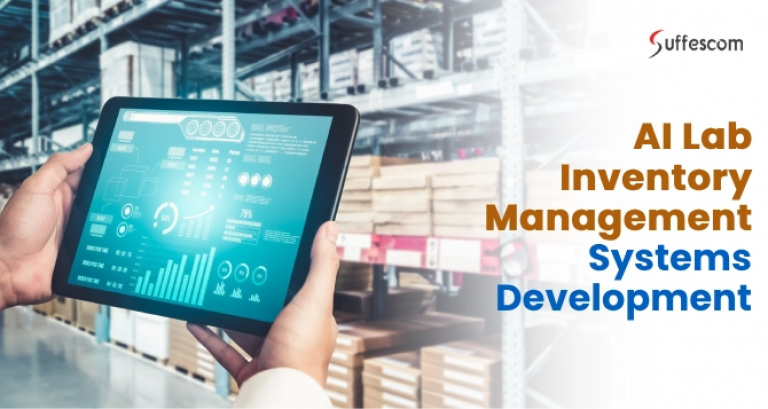Digitize Your Lab with AI Lab Inventory Management System Development

In today’s fast-paced healthcare and research industries, managing laboratory inventory has become increasingly complex. It includes data from patient records to sample inventories and regulatory documents. The demand for data management is growing, and many organizations are transforming to modern digital systems. These customized solutions help manage lab workflows, minimize manual errors, and improve overall operational efficiency by providing a proper focus on lab data management through secure digital platforms.
According to the Business Research Company, the global lab inventory management software market is set to grow from $2.49 billion in 2024 to $2.79 billion by 2025. It reflects how research facilities, hospitals, and diagnostic centers are adopting digital tools like AI LIMS Software Solutions and AI-powered lab inventory management systems to overcome outdated, paper-based processes. This blog provides comprehensive information on the fundamentals of LIMS software development. It includes essential features, AI-driven upgrades, market examples, and how custom lab software can future-proof your operations.
What is Lab Inventory Management Software?
Lab inventory management software is a digital system that assist laboratories to manage and control their inventory. It includes reagents, chemicals, and all the laboratory's assets. It helps to maintain real-time visibility of stock levels, expiry dates, storage locations, and consumption records, that offers a unified platform to optimize inventory workflows.
While LIMS software development addresses wider laboratory operations, such as patient data management, sample testing workflows. A lab inventory management software focuses solely on stock control and inventory automation. The software is used in healthcare laboratories and pharmaceutical manufacturing facilities. Each sector depends on accurate inventory control to fulfil regulatory standards and ensure uninterrupted lab operations.
Key Benefits of Lab Inventory Management Software Development
These advantages help to position healthcare and research enterprises for more innovative, scalable, and compliance-ready inventory management.
1. Real-Time Inventory Tracking:
Gain immediate, accurate visibility of what is in stock and what is stored, and when it expires. It is valuable for multi-location labs and enterprise healthcare providers to supervise high stock volumes.
2. Automated Stock Alerts:
Relies on manual checks, as the system generates timely alerts for low stock levels. This proactive functionality minimized the chances of operational delays and compliance issues.
3. Equipment Maintenance Scheduling:
The software tracks laboratory equipment status and automates service reminders to manage reagents and consumables. It helps to prevent unexpected equipment breakdowns that make lab operations smooth.
4. Compliance Management:
To regulate industries, maintaining accurate digital records is essential. The software ensures that it checks every inventory transaction, movement, and usage log. It simplifies audits and helps labs to meet industry regulations with ease.
5. Audit-Ready Inventory Records:
Laboratories are required to go through routine inspections and regulatory checks. Keeping clear, organized inventory records ensures the audits are completed efficiently, minimizing downtime and operational disruptions.
6. AI-Driven Inventory Forecasting:
Lastly, by analyzing usage patterns and lab activity, the system’s AI-driven forecasting tools help predict future stock needs. This ensures timely procurement, avoids shortages, and reduces excess inventory , a significant operational and financial advantage for B2B healthcare and research organizations.
Ready to Simplify your Lab Workflows and Inventory Control?
Partner with us for secure, AI-powered laboratory management software development built for modern labs.
Must-Have Features in a Lab Inventory Management System
The right set of functionalities can make a laboratory management system modern. It can handle the day-to-day demands of healthcare, research, and pharmaceutical operations. Below are the essential features for an efficient lab management system software
1. Sample & Reagent Tracking
A sound system includes the details of every item. Helps to make it easy for lab teams to locate, update, or check stock without wasting time. Centralized records minimize the risk of errors across multiple lab locations.
2. Barcode and QR Code Integration
Manual data entry narrows down the workflows and increases the risk of mistakes. So integrating barcode or QR code scanning is crucial to simplify the inventory update process. It saves valuable time during busy lab hours.
3. Inventory Prediction and Stock Forecasting
Analyzing past usage patterns and forecasting upcoming needs helps to fluctuate stock demands. It ensures that you never run out of essential supplies or overstock items. This feature helps in controlling operational costs and maintaining consistent availability of critical materials.
4. Automated Purchase Order Requests
Automated purchase order requests, the system sends reorder alerts or directly triggers supplier requests when inventory drops below a certain level. This ensures a steady supply of essential items without constant manual checks, keeping workflows uninterrupted.
5. Integration with AI LIMS Software Solutions
Seamlessly integrate with existing LIMS software development systems for synchronized workflows, automated test-to-inventory mapping, and better operational control.
6. Centralized Asset Management
Managing laboratory equipment is helpful for handling consumables. From tracking analyzers to monitoring calibration schedules, these features help to keep everything organized. It ensures that lab instruments are adequately maintained, operational, and ready for use when needed.
7. User Access Control and Audit Trails
Labs often work with sensitive data and regulated materials. It gives access to inventory records and tracks every stock movement, maintaining data security. With role-based permissions and clear audit trails, labs can easily manage accountability and meet regulatory standards.
8. Automate Assigning Process
Tracking your samples, reagents, and lab consumables shouldn’t be a manual task. A robust LIMS incorporates real-time inventory management, stock level alerts, container tracking, and location audit logs. It ensures what is in stock and where critical items are stored.
9. Workflow Automation
Use automated workflows to streamline repetitive processes like maintenance logs, purchase requests, and stock updates. This speeds up operations, minimises manual labour, and maintains connectivity across various lab activities.
10. Compliance Administration
To satisfy FDA, NABL, and ISO requirements, keep safe, traceable digital records of equipment maintenance, stock movements, and usage. This guarantees that your lab maintains compliance without requiring additional administrative labour and facilitates audits.
11. Analytics and Reporting
To monitor stock levels, expiration dates, consumption trends, and inventory trends, access real-time dashboards and reports. These insights aid labs in better procurement planning, cost management, and stock control.
12. Notifications and Alerts
Receive alerts in real time on equipment servicing, impending expiration, low stock, and order approvals. This guarantees continuous lab operations, avoids delays, and keeps your team informed.
13. Automated Re-order Suggestions
The system quickly alerts the team or sends a reorder request when stock levels are low. To ensure that the lab always has what it needs without anyone having to manually check it.
14. Smart Anomaly Detection
Labs handling sensitive or high-value materials can’t afford inventory mistakes. AI tools continuously monitor stock activity and flag any unusual trends such as sudden usage spikes or missing items. Helping managers take quick action before small issues turn into costly problems.
15. Payment Payroll Scheduling
AI empowers payroll management system with in short time frame, tax compliance, and customizable employee payment cycles for lab financial management.
16. Track Sample Storage and Location
AI helps to track blood samples location and reports in real-time with barcode technology to ensure precise retrieval, minimize loss, and optimize lab inventory management.
17. Assign Items to Specific Lab Projects
Link inventory items directly to research projects, enabling organized tracking, usage accountability, and efficient resource allocation within the lab.
Popular Industry Use Cases for Lab Inventory Management
Whether it’s a clinical lab or a biotech facility, implementing an AI Powered lab inventory management system simplifies stock management, compliance reporting, and multi-site inventory tracking. Here’s where these systems make a noticeable difference:
1. Pharmaceutical Research
Pharma labs handle sensitive chemicals and research samples. Since these materials often expire or need some special storage, tracking them manually is risky. A lab inventory management system helps to manage everything that makes sure nothing goes to waste.
2. Clinical Diagnostic Labs
Diagnostic labs manage constant stock movement, from reagents to test kits. Analyzing proper tracking, supplies can run out or expire unnoticed. Using a lab management system helps to send alerts, manage reorders, and stay on top of expiry dates without the hassle of manual checks.
3. Environmental Testing Labs
These labs analyze soil, water, and air using various testing agents. Without a system in place, it's simple to get off course. An inventory management tool tracks usage, maintains material organisation, and greatly simplifies audit preparation.
4. Life Sciences and Biotechnology
Biotech businesses handle sensitive materials, including biological samples and cell cultures. A single minor error can derail research. From the location of storage to the expiration date, a lab inventory management system tracks everything to ensure that no item is missed.
5. Networks of Multiple Locations in Labs
For labs with multiple branches, managing stock across facilities is a regular difficulty. A centralised, AI-powered lab inventory system offers a single view of inventory that makes transfers and reorders easier. Facilitates transfers and reorders, and safeguards against shortages.
How to Develop a Custom Lab Inventory Management System
An expert bespoke software development company begins by conducting a thorough workflow analysis to identify gaps, inefficiencies, and integration opportunities.
1. Business Requirement Analysis
The development process starts with a detailed evaluation and inventory of complications within the lab. It ensures the software is customized according to needs, tackles actual workflow gaps, and improves overall stock management efficiency.
2. Choosing Bespoke or Off-the-Shelf Solutions
Once objectives are clear, the next step involves selecting between bespoke software solutions or Off-the-Shelf solutions options. The decision basically depends on project scope, regulatory needs, and the level of inventory control required.
3. Selecting the Right Tech Stack
After finalizing the platform approach, choose the suitable technology stacks. Make sure it supports AI, IoT, and cloud integration. It enhances system performance, enabling remote inventory tracking, and lays the foundation for future scalability.
4. AI, IoT, and Cloud Integrations
After the tech stack is sorted, it’s time to make your inventory system truly smart. Integrating AI and IoT brings in features such as predictive stock alerts and automatic data syncing from connected lab equipment. Instead, adding cloud support ensures your inventory data stays safe and can be accessed from anywhere. It is convenient for labs running operations in multiple locations.
5. Testing and Deployment
Before proceeding the process, testing is conducted to confirm system stability and security. This phase helps in resolving technical issues in advance, ensuring a reliable and interruption-free launch.
6. Post-Launch Support
Ongoing support is equally important as it covers regular updates, security enhancements, and compliance adjustments. A trustworthy laboratory software development company provides long-term assistance that makes a platform to meet business needs and industry standards.
Streamline Stock Handling and Compliance Tracking without Manual Effort.
Get started with an expert lab management system development built around your workflows.
How Much Does Lab Inventory Management Software Development Cost?
It may range from $10,000 - $ 30,000.The cost of lab inventory management software development depends on the features and AI modules, Integration requirements with LIMS software development, and the depth of customization for bespoke software solutions.
| App Type | Cost Estimation |
| Basic system | $10,000 – $15,000 |
| AI-integrated mid-range system | $15,000 – $20,000 |
| Enterprise-grade system | $30,000+ |
Recommended Tech Stack for Lab Inventory Management Software
Choosing a reliable, scalable tech stack lays the foundation for a secure, AI-ready, and future-proof lab inventory management solution.
| Frontend | React.js, Angular, Vue.js |
| Backend | Node.js, Python (Django / Flask), .NET Core |
| Database | PostgreSQL, MongoDB, MySQL |
| Cloud & Hosting | AWS, Microsoft Azure, Google Cloud Platform (GCP) |
| AI & Analytics | TensorFlow, PyTorch, Power BI, Google Cloud AI |
| Mobile App (if required): | React Native, Flutter |
Best Practices for Lab Inventory Management Software Development
To build an efficient and scalable lab inventory management software development solution, it’s essential to follow the best practices.
1. Start with a Clear Requirement Analysis
Every successful project begins by identifying operational challenges early on. It’s crucial to figure out inventory workflows, stock movement patterns, and recurring bottlenecks before finalizing system features. It helps to prevent gaps and ensures the software addresses real business needs.
2. Prioritize Real-Time Tracking and Alerts
Next, a modern inventory system should be capable of delivering instant stock updates and timely reorder alerts. It helps to minimize the risk of delays and operational disruptions.
3. Integrate AI for Forecasting and Analytics
Integrating AI-powered lab inventory management systems adds measurable value. These tools predict stock demands based on historical usage, consumption patterns, and automate reorder decisions that make inventory handling more proactive.
4. Ensure System Security and Data Compliance
Since inventory data includes numerous sensitive records such as samples, chemicals, and healthcare materials. Incorporating role-based access control and digital audit trails helps labs remain compliant with industry regulations.
How Suffescom Can Help in Developing Robust LIMS Software Solutions
As a trusted laboratory software development company, Suffescom Solutions specializes in building secure, scalable, and AI-powered LIMS platforms. Here’s how our team adds value to fulfill your business needs:
1. Industry-Specific Expertise
With multiple years of experience across healthcare, biotech, and life sciences, our team brings a clear understanding of lab inventory complexities. Backed by proven expertise in healthcare app development, our team can automate the workflows, and address evolving regulatory demands. This enables the creation of lab-friendly solutions that address operational challenges.
2. Custom-Built, AI-Driven Modules
We deliver AI LIMS Software Solutions that are customized according to your workflows. Our team integrates advanced modules for inventory tracking, sample management, reporting, and compliance. Our expertise goes beyond healthcare apps; we combine it with enterprise software development practices to build scalable, secure, and AI-driven LIMS platforms.
3. End-to-End Project Delivery
From requirement analysis, system architecture, UI/UX design, and development to testing, deployment, and post-launch support. We manage the complete LIMS software development lifecycle, offering solutions that are secure, reliable, and customized according to the lab's needs.
4. Compliance-Ready and Secure
Our team designs the system with proper data security. Platforms should comply with healthcare regulations, such as HIPAA and GDPR. With role-based access control, patient data remains secure and protected. Thus, we ensure that your lab operations stay compliant and protected.
FAQs
1. Why should healthcare and research labs invest in AI-powered lab inventory systems?
AI-powered inventory systems help labs to predict stock demands and automate reordering tasks. It helps to reduce manual tracking and ensures better decision-making through real-time data insights.
2. Can lab inventory software integrate with existing LIMS platforms?
Yes, most of the modern lab management system development projects prioritize building API-ready solutions that smoothly integrate with AI LIMS Software Solutions. It ensures through connected workflows, real-time data exchange, and reduced manual updates.
3. Are free LIMS systems a good option for small labs?
Free or open-source LIMS options perfectly work for small labs with limited inventory needs. However, most labs prefer bespoke software solutions for better scalability, security, and AI integration.
4. Do lab inventory systems support mobile access?
Most modern lab management system development projects include mobile-friendly dashboards or dedicated apps. It allows lab teams to manage inventory, place reorders, and check stock levels remotely.
5. How often should lab inventory software be updated?
To maintain compliance and security, it’s appropriate to schedule system updates and security patches at least quarterly. Post-launch support contracts often involve the software vendor.








